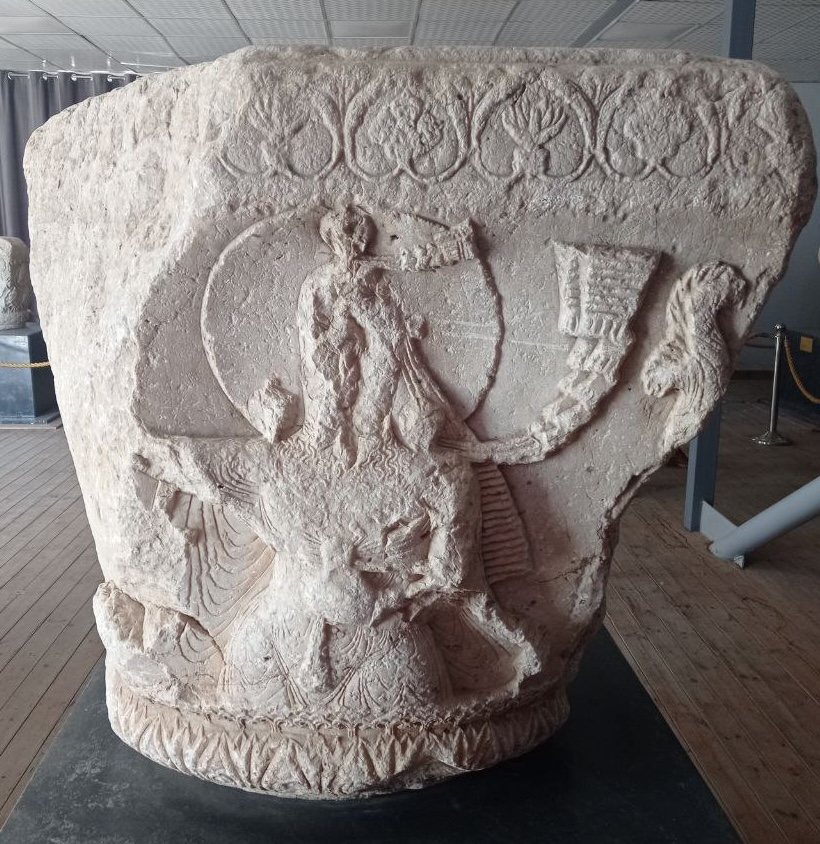Thread: A while back I wrote an article about this the Khafajeh vase, which was made in Iran in the mid 3rd mil. BC by the people of the Jiroft culture...It is still one of the most amazing animal calendars I have seen so far oldeuropeanculture.blogspot.com/2020/09/khafaj… 

This particular scene depicts the driest and hottest part of the year in the Jiroft County, located in the Kerman Province of the South-Eastern Iran...Jul/Aug...This is symbolised by the person holding two snakes (symbols of sun's heat) standing between two lions (in Leo)... 

This "person" is the sun god, the same dude depicted on this Bactrian seal from the same period. I talked about Bactrian snakes and dragons in this article
oldeuropeanculture.blogspot.com/2020/06/bactri…
oldeuropeanculture.blogspot.com/2020/06/bactri…

What I didn't notice at the time when I wrote my article were the tips of the lions' tails. They end in what looks like wheat ears...Why? Is this significant? 

Well, in this article about this amazing cylinder seal, oldeuropeanculture.blogspot.com/2021/05/shamas… I talked about young and old sun god Utu/Shamash from Mesopotamian mythology... 

Utu/Shamash is also depicted as a bull with human face and long flowing beard...This is one of those depictions of the sun god Utu/Shamash as a bull with human face and a long flowing beard. But this time he also has a tail that ends in a ear of wheat...Why? Is this significant? 

Well it is. Utu/Shamash is depicted as a bull, cause hot dry part of the year dominated by the sun starts in Apr/May, in Taurus, the time when Wild Eurasian Cattle begin to calve... oldeuropeanculture.blogspot.com/2021/06/dairy-… 

This is also the time of the peak flood of the Tigris and Euphrates, which is caused by the snowmelt on the mountains that feed these two great rivers, which is in turn caused by the sun, Utu/Shamash...Hence golden bull with blue lapis (water stone) beard oldeuropeanculture.blogspot.com/2021/10/green-… 

Apr/May, Taurus, is also the time when the grain harvest begins in Mesopotamia...Hence bulls and grain...And bulls with grain tails...
oldeuropeanculture.blogspot.com/2021/10/bulls-…
oldeuropeanculture.blogspot.com/2021/10/how-gr…

oldeuropeanculture.blogspot.com/2021/10/bulls-…
oldeuropeanculture.blogspot.com/2021/10/how-gr…


But what does this have to do with the lions with grain tails from the Jiroft vase? Well..."wheat harvest season is approximately 4.5 months in Iran starting in early April up to mid-August, depending on the region and it's local climate"...
According to this paper about the affect of the global warming on grain agriculture in Iran researchgate.net/publication/33…
"...most of the wheat in Iran is cultivated in October and harvested in July..."
"...most of the wheat in Iran is cultivated in October and harvested in July..."
And finally I found this: "KERMAN, Aug. 13 (MNA) – Farmers of Deh Ziyar village in Kerman province, harvest wheat using traditional methods"...
en.mehrnews.com/photo/148819/T…
Basically they are harvesting grain in Leo...



en.mehrnews.com/photo/148819/T…
Basically they are harvesting grain in Leo...




Is Jul/Aug really grain harvest season in Kerman province? Is this why lions on this vase made by the people of the Jiroft culture from the Kerman province of Iran have tails that end in grain ears?
I just looked at the pictures of the wheat being harvested in Kerman province. It looks like one of the old wheat types, emmer, durum, which are both awned (with bristles)... 

Durum wheat is the predominant wheat type grown in the Middle East. And it is traditionally a "spring wheat" which is sown in Feb/Mar and harvested in Jul/Aug. It has lower yields, thick husks, long bristles and is resistant to high temperatures...
It fits...
More about animal calendar markers found in ancient cultures, start here oldeuropeanculture.blogspot.com/p/animal-solar… then check the rest of the blog posts I still didn't add to this page, and finally check my twitter threads I still didn't convert to blog post...I am 7 months behind now
More about animal calendar markers found in ancient cultures, start here oldeuropeanculture.blogspot.com/p/animal-solar… then check the rest of the blog posts I still didn't add to this page, and finally check my twitter threads I still didn't convert to blog post...I am 7 months behind now
• • •
Missing some Tweet in this thread? You can try to
force a refresh























